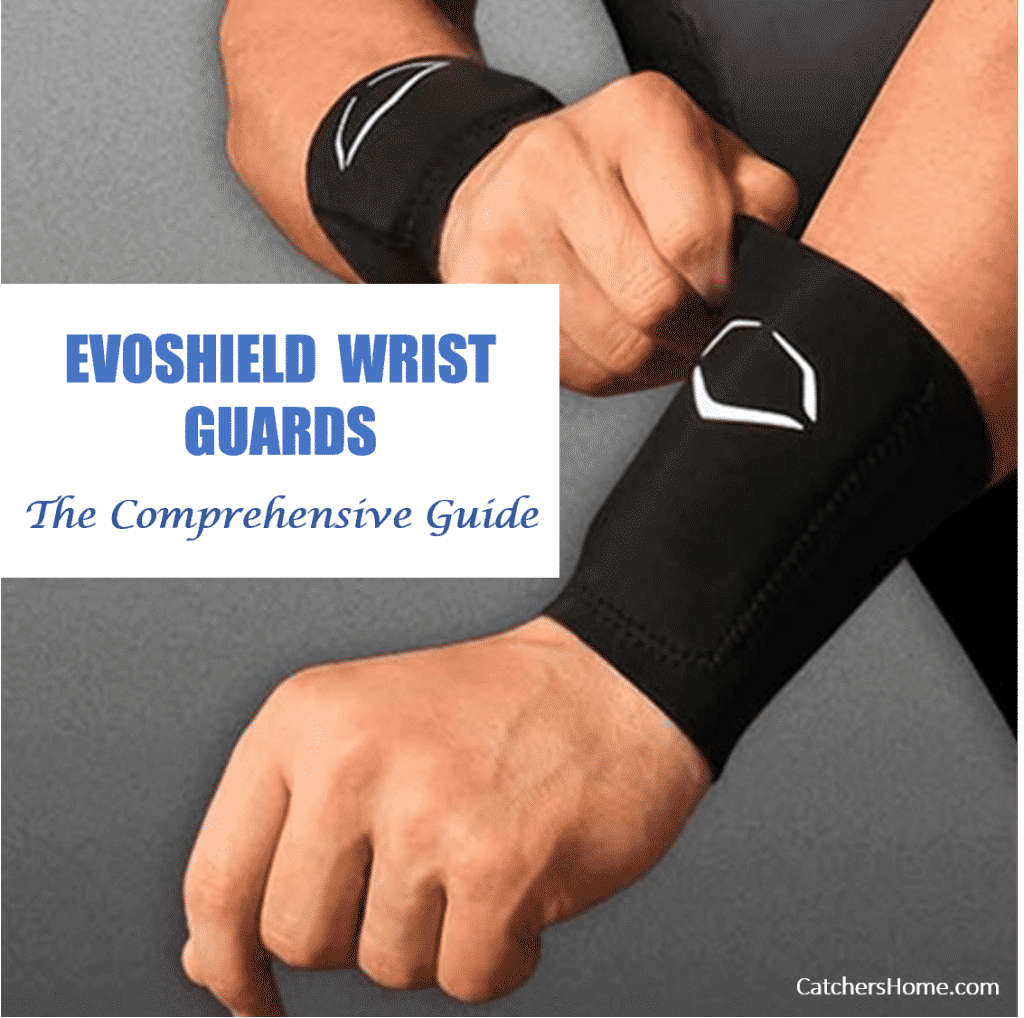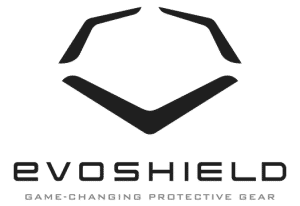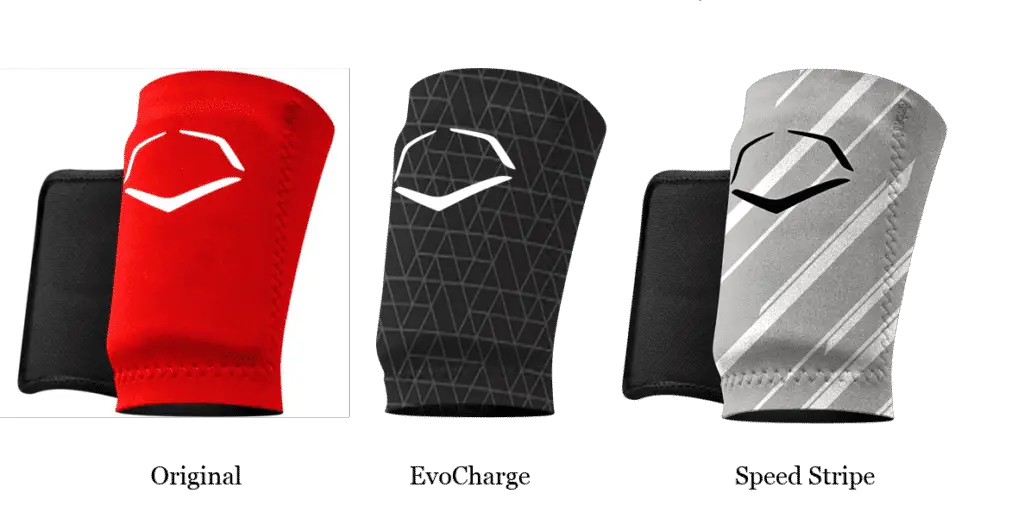(If you click on links we provide, we may receive compensation. See more.)
EvoShield's Protective Wrist Guards are a great asset behind the plate, as they help to protect a vulnerable part of a catcher's arm from injury.
This guide provides you with a comprehensive overview of these innovative wrist guards. Keep scrolling to find out more...
Background on EvoShield
EvoShield was started in 2006 by a group of former athletes from the University of Georgia.
The young company quickly differentiated themselves from their competitors due to the innovative technology they developed.
Essentially, what they created was a gel type of substance that hardens within a sleeve upon first use, providing the wearer with a customized fit.
This stood in stark contrast to other types of protective guards on the market at the time, which were one size fits all.
Since EvoShield's products first hit the market, the company has exploded in popularity.
Their gear is now used widely among football, baseball and fastpitch softball players - including among many catchers.
Only ten years after the company started, EvoShield was bought by Wilson Sporting Goods in 2016. Even though Wilson bought them, EvoShield's unique products are still manufactured and sold.
Products that EvoShield Makes for Baseball and Fastpitch
EvoShield makes a wide variety of products for both baseball and fastpitch softball players.
Their primary products include, but are not limited to, the following:
- Catcher's Gear
- Leg Guards
- Elbow Guards
- Wrist Guards
- Sliding Wrist Guards
- Thumb Guards
- Chest Guards
- Compression Arm Sleeves
Additional products made by EvoShield include:
- Batting Gloves
- Batting Helmets
- Playcall Wrist Sleeves
- Compression Tights
- Apparell (ie, shirts and hats)
Pro Catchers who use EvoShield
Professional players (including catchers) are heavy users of EvoShield's gear.
Whether at bat or behind the plate, MLB catchers who currently use EvoShield products include names like Tyler Stephenson, Gary Sanchez, J.T. Realmuto, Willson Contreras, and more.
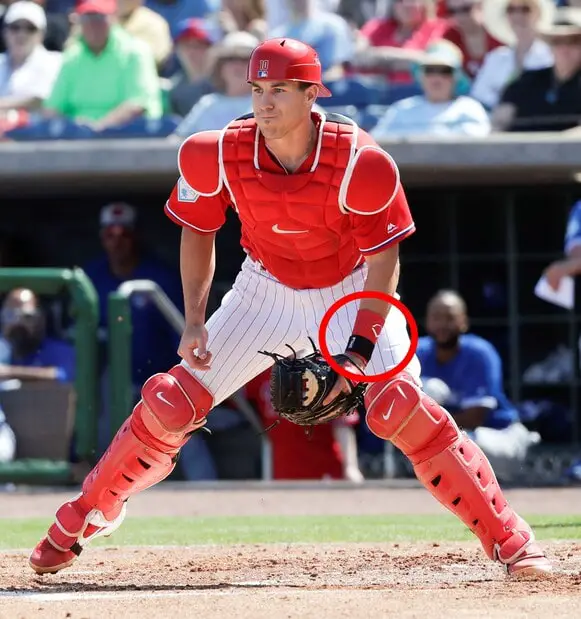
Among Fastpitch Softball players, EvoShield users include - or have included - names like Aubree Munro, Courtney Gano, and Sierra Romero, among others.
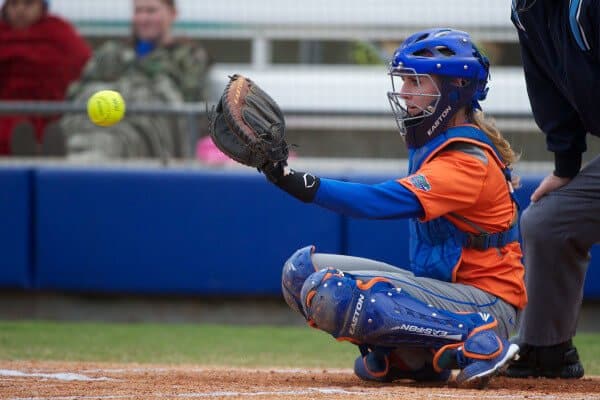
Reviewing EvoShield's Catchers Wrist Guard
Now that you have a little bit of background on EvoShield and their products, we want to take a detailed look at one of their more useful products for baseball and fastpitch softball catchers - the protective wrist guard.
Our goal is that this review educates you about every major aspect of the EvoShield catchers wrist guard so that you can make an informed buying decision and so that you can understand how to properly use it.
How They Help
EvoShield's Protective Wrist Guard is designed to be worn from the base of the wrist on your glove hand up your forearm by about 5 inches.
This baseball wrist guard compresses the wrist and helps protects catchers from wild pitches and bad hops in general that could be directed to that part of the body. The picture below demonstrates this well.
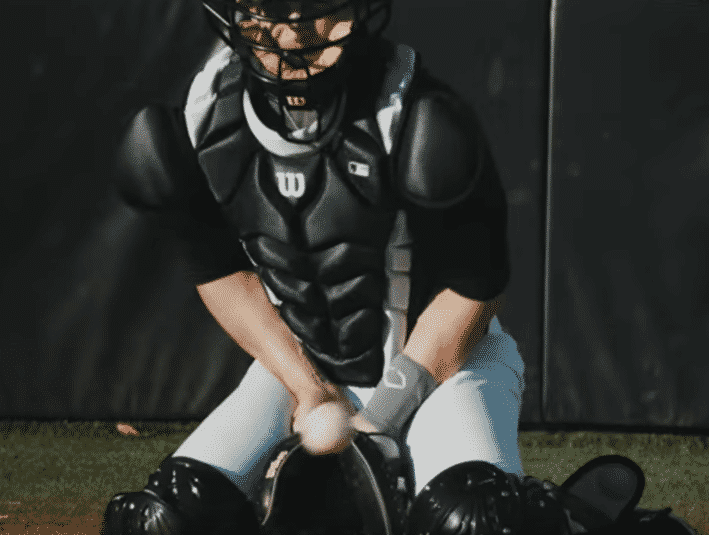
This catchers arm guard is reversible, so you can also wear it at the plate.
When worn while batting, the guard can help protect you from serious injury if a wild pitch hits you on the wrist.
When struck, the wrist guard does a good job of dispersing the impact, helping to limit the pain and soreness in general.
Materials
There are two primary components of the wrist guard: the shield, and the sleeve that holds the shield.
The sleeve is made out of neoprene, which is a fairly common synthetic rubber material found in lots of different sports apparel.
The shell starts off as a porous gel like material. When it's exposed to air, however, the moisture in the air creates a reaction that causes the gel to harden into a rigid plastic mold in around 20 to 30 minutes.
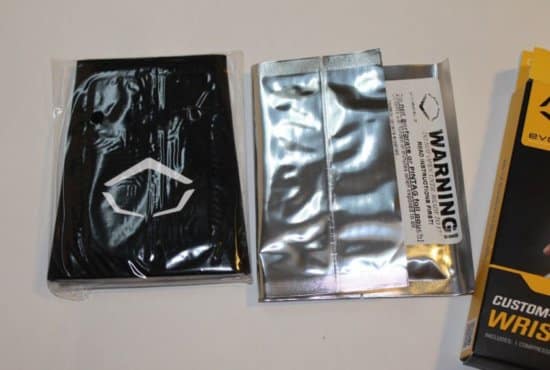
Much of the information about the chemical process involved and the actual makeup of the gel is proprietary to EvoShield and kept secret.
Sizes and Dimensions
The wrist guard is available in four sizes: small, medium, large, and extra large. Size is not based on age but on wrist circumference.
It's actually quite easy to determine your wrist circumference. All you need to do is grab a cloth tape measure (or something similar) and wrap it around the base of your wrist to determine your measurement. Simple.
Based on the size chart on the back of the box, if your measurement is between 5 and 6 inches, you are a small; between 6 and 7 inches, a medium; between 7 and 8 inches, a large; and between 8 and 9 inches, an extra large.
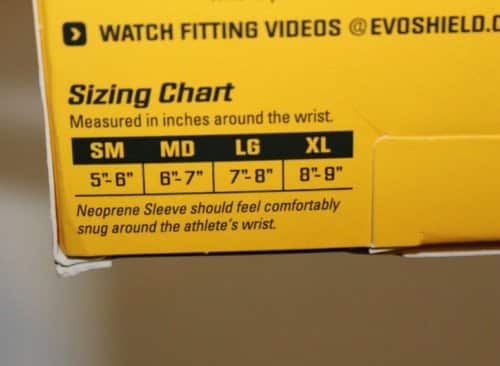
If your measurement is somewhere on the border of each size, then it's up to you: simply choose the next size up for a looser fit, or the size below for a tighter fit.
In terms of the dimensions of the wrist guard, the sleeve measures 5 inches in length and the shield measures 3"W x 4"H.
Colors and Designs
These wrist guards are available in three primary designs, distinguished only by how they look. Otherwise, they are the same guard.
The first design is called the "EvoCharge Protective Wrist Guard", which uses multiple small rectangles and triangles etched in the sleeve.
Second is the "Speed Stripe Wrist Guard", which utilizes a stripe based design on the sleeve.
The third is the original Protective Wrist Guard, which does not have any graphics on the sleeve, just a solid color.
Each of these designs are available in a very large number of colors (including some with a camo design). Of course, on any given day one retailer may have a wider selection of colors to choose from than another one has.
As an example, Amazon currently has a number of different colors stocked for each of the designs mentioned above. Click the link below to check out their current inventory.
How to Mold an EvoShield Wrist Guard
One of the things that most people are confused about when they first receive the package is how to get the guard to custom fit their wrist.
It's actually pretty straight forward and simple to do. In fact, this brief video shows it much better than we would be able to describe in detailed writing. Check it out.
That's it. Simple, right? You just rip it, fit it, wait, then use it.
How to Clean the Guard
Playing behind the plate is a tough job, as everyone reading this post knows. So undoubtedly you will get a catchers wrist guard like this dirty after some use.
To clean it, you should thoroughly wash it by hand, then let it air dry. We don't recommend putting the wrist guard in a washer and dryer - go with the old fashion hand washing method instead.
In Summary
Fortunately, EvoShield's wrist guards are super affordable, they're widely available, and they come in many different colors and sizes.
They are an innovative piece of protective gear and a welcome addition to baseball and fastpitch softball fields.
Quite simply, they are one of the best catchers arm guards out there.
Combining these facts with the safety benefits they offer, our recommendation is that the EvoShield wrist guard for catchers should definitely be a part of every backstop's arsenal of gear.
Check them out at one of our links below.
Check Price of EvoCharge Guard
Frequently Asked Questions
Question: Can youth catchers use the Evoshield wrist guard?
Answer: Absolutely! As mentioned above, wrist guards by EvoShield come in a variety of sizes, from small to XL.
If your young catcher has a wrist size that fits in the range, then you're good to go. And lots of youth catchers do.
We know, for example, that the small size fits many 7 - 9 year olds, generally speaking.
Question: What do catchers wear on their wrist?
Answer: Many catchers wear protective wrist guards, such as those we feature above.
But that's just one of many options.
Some catchers have PitchCom transmitters on their wrist.
Others have a wrist strap that connects to their catcher's mitt.
And some simply use wrist tape, a sweatband, a combination of these options, or nothing at all.
Like many things, it mostly depends on the person's preference.
Question: Why do baseball players tape their wrists?
Answer: The reason why baseball players tape their wrists varies for a number of personal reasons. One of those reasons is that it stabilizes the wrist, which is important especially for catchers who constantly receive pitches.
Another reason is that tape can help a player recover faster from a wrist injury, and prevent wrist pain.
Wrist tape also works to prevent injuries to the wrist, thanks to the tight compress that the tape provides. This is arguably the most common reason why baseball players tape their wrists.
Thanks for Reading!
We hope that this info and our review of EvoShield's catcher wrist guard was helpful to you.
If you have any questions for us - whether it's about protective wrist guards or just catching in general - then don't hesitate to reach out by heading over to the Contact Us page or by emailing scott [at] catchershome [dot] com.
Scott Perry
Scott Perry is the owner and lead author at Catchers Home. He's a former baseball player, a current coach, a husband and a Dad. He remains as passionate about baseball today as he was as a kid.

